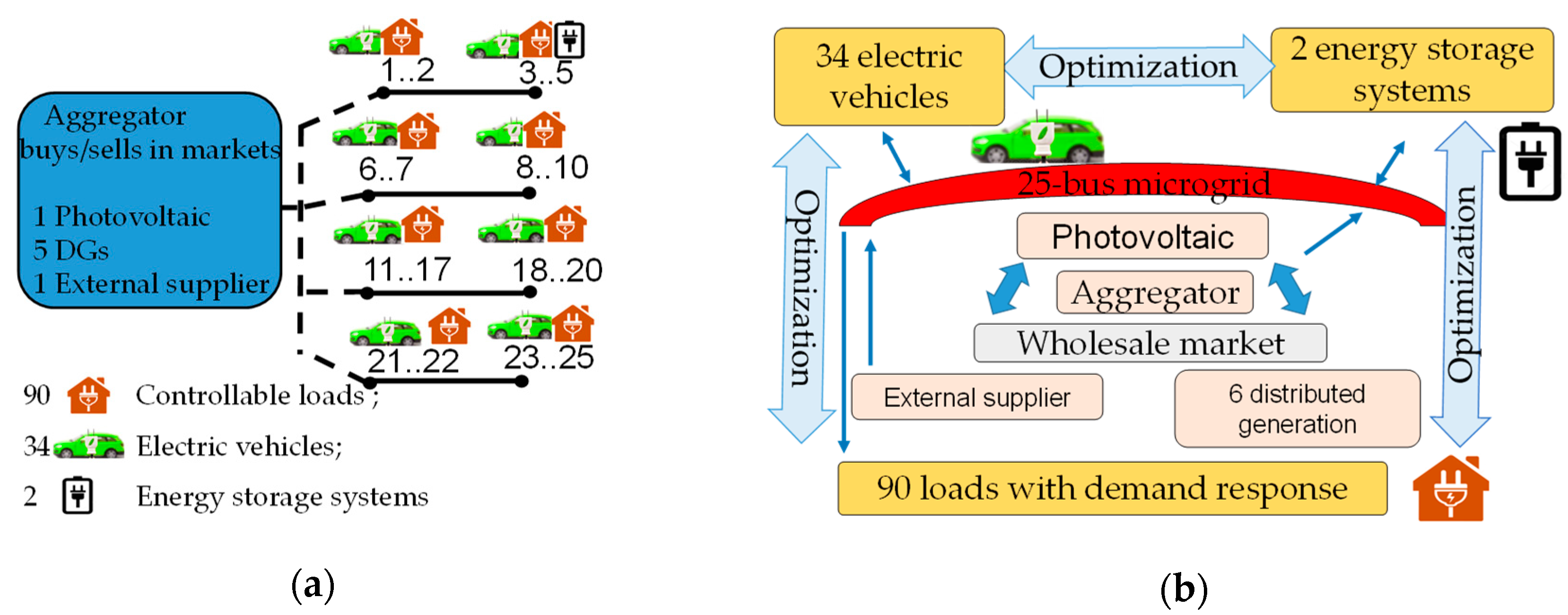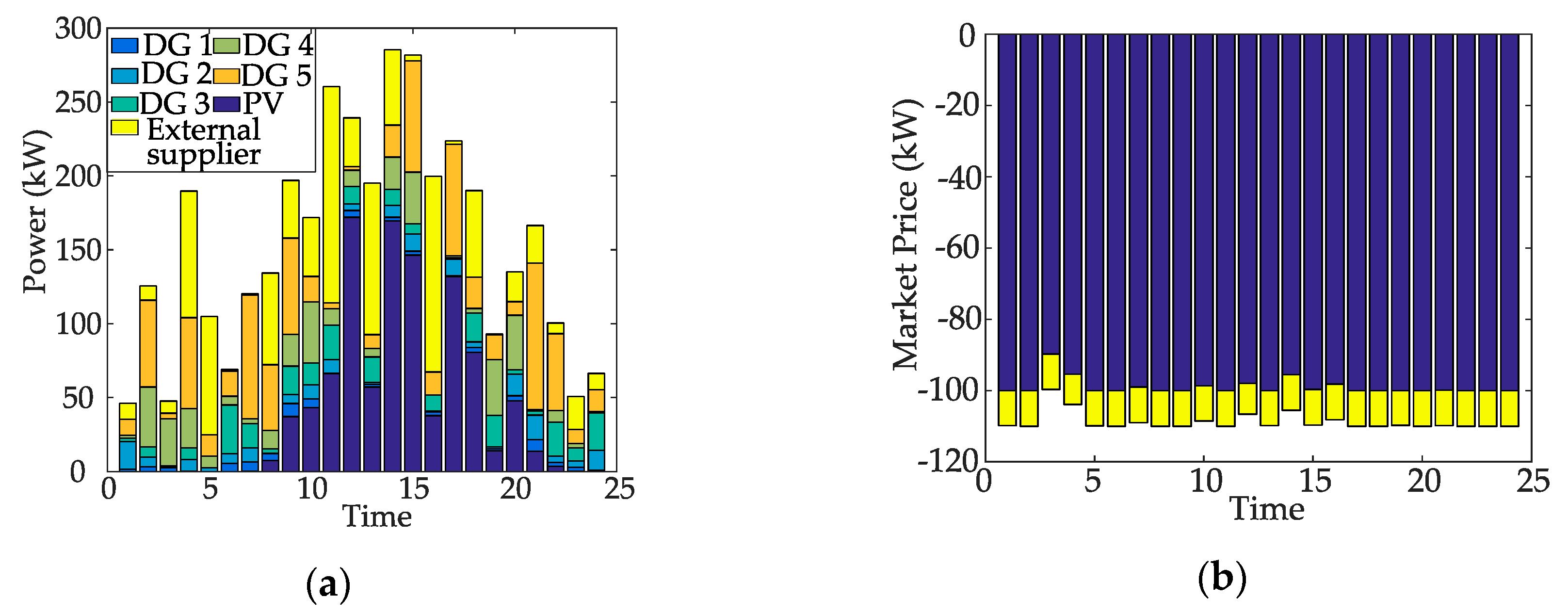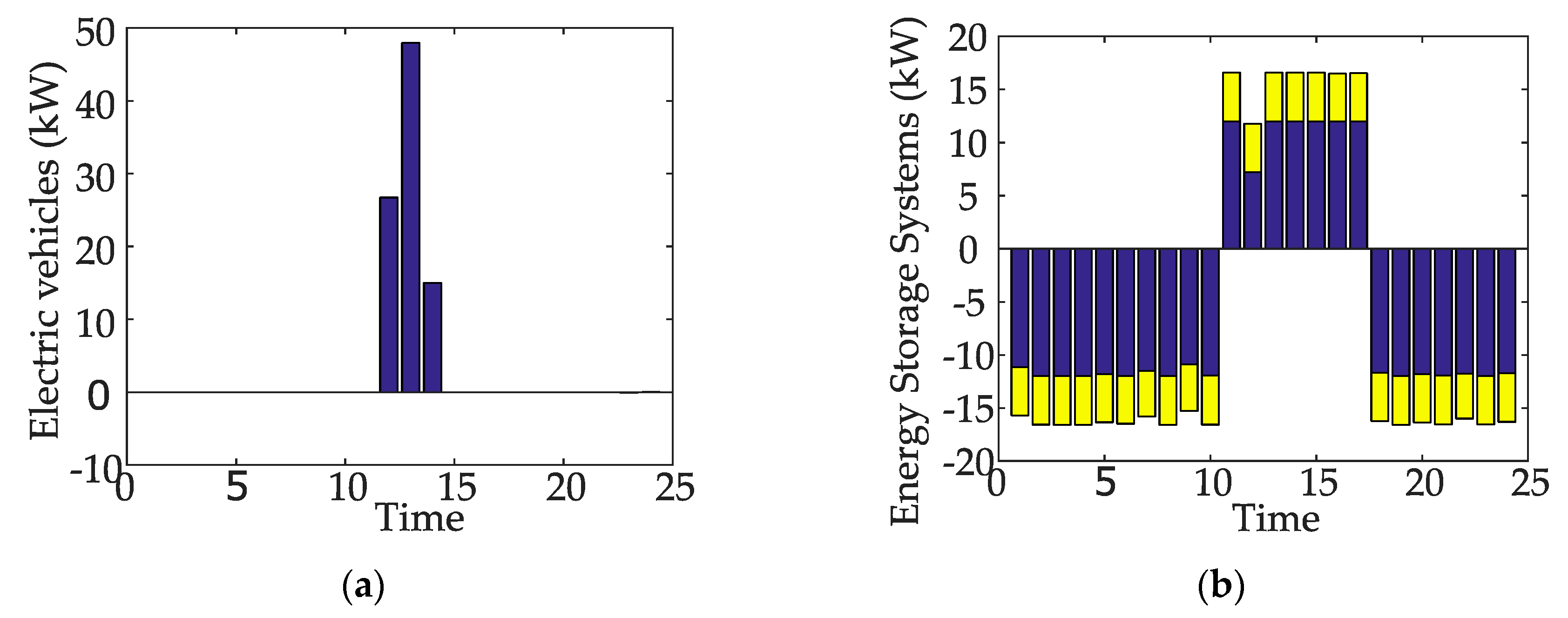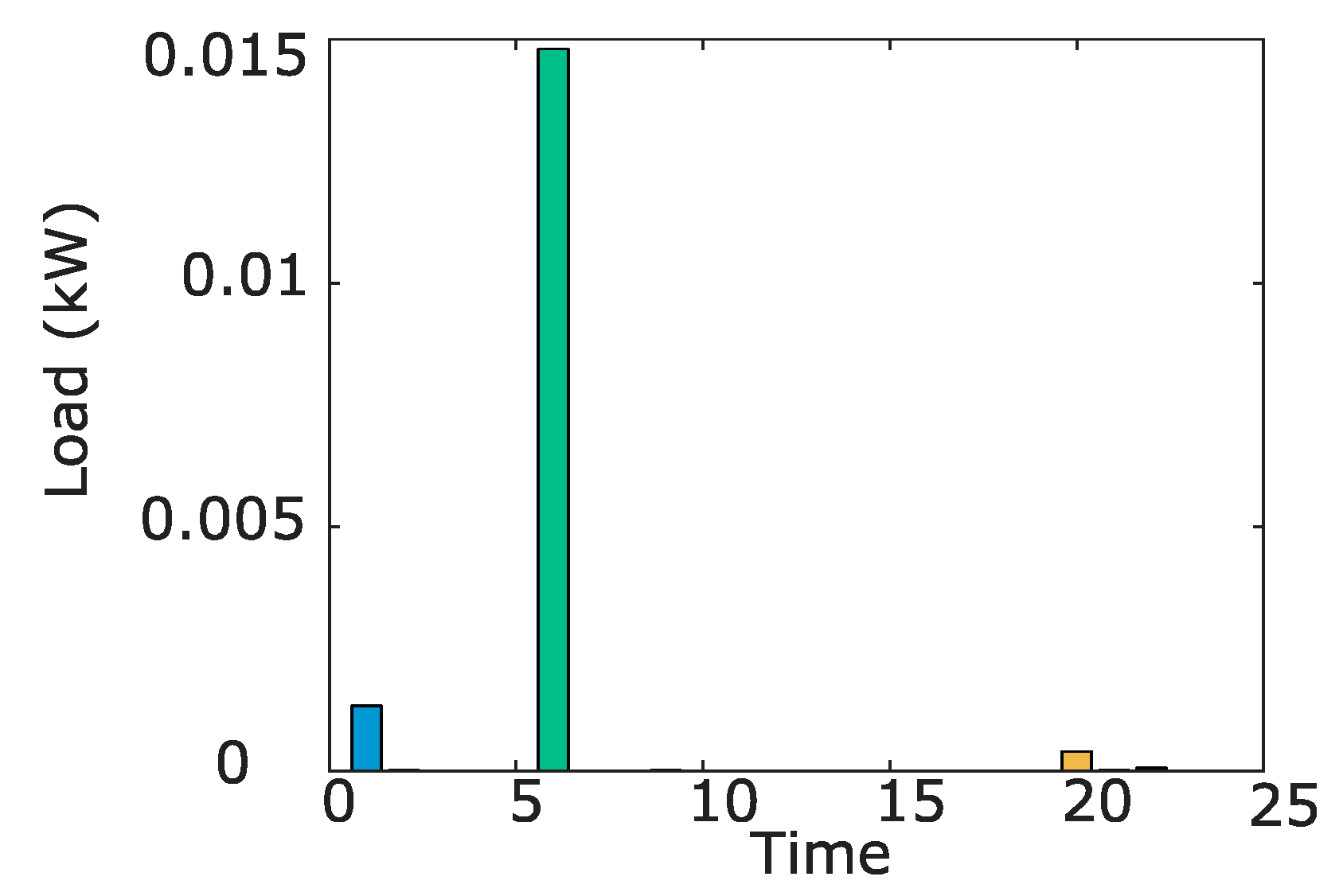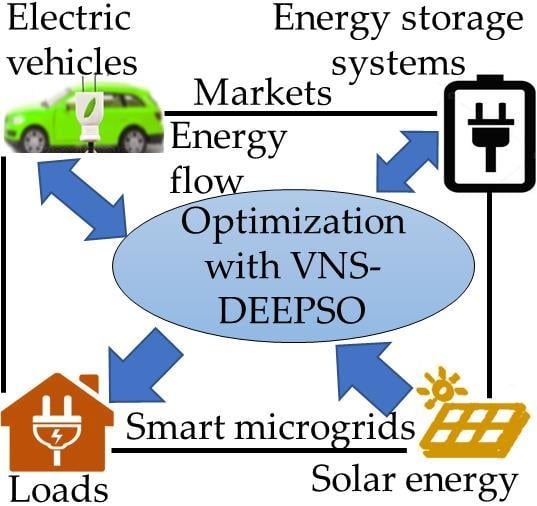1. Introduction
Decarbonization is a very important industrial and societal trend that is driving the adoption of renewable generation technologies and transportation electrification. Smart microgrids integrate elements such as EVs and generation with renewable energies [
1]. In addition, microgrids are designed to encourage the participation of users, for instance, via demand response programs in competitive electricity markets [
2]. Smart microgrids are systems that exhibit intelligent behavior, both at the individual level (which includes the planning of distribution systems, generators and users [
1,
3]) but also at the system level (such as coordination between microgrids). They are self-sufficient, independent and operate in a coordinated fashion [
1]. Finding solutions to problems with smart microgrids have inspired the use of heuristic and metaheuristic optimization algorithms, due to the intractable nature of model-based analytic solutions [
4]. Heuristic-based optimization techniques can improve the performance of electric microgrids, by providing near optimal solutions in acceptable calculation time [
5]. In some of these real-life problems, uncertainty is an additional challenge to problem formulation.
The international Genetic and Evolutionary Computation Conference (GECCO 2019)/IEEE congress on evolutionary computation (IEEE-CEC 2019) and IEEE World Congress on Computational Intelligence (IEEE-WCCI 2018) competitions call to present complex metaheuristic optimization solutions to complex real-life problems, specifically for smart microgrid operation [
5,
6]. The test bed competition was developed by the group GECAD (Research Group on Intelligent Engineering and Computing for Advanced Innovation and Development), based at the Polytechnic Institute of Porto, in collaboration with Delft University and Adelaide University [
5,
7]. The organizers of theses competitions provide a free framework (an encrypted test bed) in order to test heuristic algorithms for the smart microgrids scheduling, the framework can be downloaded freely from
Supplementary Materials [
5,
7].
Although there are several explicit mathematical formulations, due to the complexity of smart microgrids models, they cannot be solved efficiently [
6]. In cases where analytical model-based formulations become intractable, it has been demonstrated that heuristic and metaheuristic algorithms are a reliable option [
7]. Additionally, some heuristic-based algorithms with acceptable results considering environmental uncertainties include Monte Carlo simulations, which allow analyzing more complex models, such as including planning of trips with EVs, penetration of renewables, variability of market prices and demand forecast [
5]. The optimization of these real-life problems requires different heuristics-based algorithms, since it is necessary to carry out the scheduling, sources of uncertainty that affect the dispatch of energy [
8,
9].
Real-time solutions of complex problems considering environmental uncertainty can be approached through different routes. Complex problems aiming modulation of energy consumption to flatten load curves [
10,
11], it can use market prices. There are also problems with scheduling the dispatch of ESS and controllable generation systems [
12], transactions in the electricity market for buying and selling energy [
6], and flexible and inflexible demand problems that include aggregators, which manage the demand of a group of stakeholders, and DER, such as EVs and ESS with charge/discharge power and buy/sell energy in the electricity markets.
In this work, we present the VNS-DEEPSO algorithm, which won first place at the GECCO 2019/IEEE-CEC 2019 and the IEEE-WCCI 2018 smart grid competitions (by GECAD group); these international competitions have assignments in different continents, Prague, Czech Republic, Europe, Wellington, New Zealand, Oceania and Rio de Janeiro, Brazil, America, respectively [
5,
7].
The algorithm is presented in its two versions. On the one hand, these versions flatten the demand curve; on the other hand, they include adaptability, evolving characteristics and contains extensions for the selection of the first population. In addition, from version one, this work discusses improvement in the exploration and exploitation of new scenarios with mathematical heuristics, and in the second version it discusses the use of heuristic rules to build the first population.
In summary, problems related to the real world demand greater awareness of the efficient use of resources, therefore the search for new optimal solutions results in this work with the following contributions:
The remainder of this document is as follows.
Section 2 summarizes the state of the art.
Section 3 presents the test case.
Section 4 presents the VNS-DEEPSO algorithm.
Section 5 presents further extensions of the algorithm and heuristic criteria for the initial solutions selection by the VNS-DEEPSO algorithm.
Section 6 presents test results. Finally,
Section 7 presents the conclusions of this work.
2. State of Art
We propose to carry out an evaluation of the case study based on the state of the art and unlike other research, the solution method will be evaluated taking the same case study, guaranteeing that each optimization algorithm that is carried out with its best performance (section results and discussion). In [
10,
11] the authors look for the interaction between providers and users to obtain economic benefits. Then, demand optimization consists of managing consumption as a function of time. In [
12] the authors integrate independent networks assuming known load profiles. Moreover, in [
13] generation forecasts with renewable resources are defined in discrete times, in addition DER such as ESS are distributed in the microgrid [
14] and minimize investment and operational costs [
13,
15]. EVs have charging and discharging capability [
16,
17] and are managed by an aggregator that uses them as network resources along with ESS [
6,
7,
18,
19,
20]. Finally, electricity price forecasts complement the operation of the microgrid [
21]. Economic data can thus be used for demand estimation [
22].
The literature proposes that the inclusion of sources of uncertainty such elements include renewable energies, load forecasting, EVs and the price market; they economically and technically affect the operator decisions of the microgrid [
11,
12,
13,
14,
15,
16,
17,
18,
21,
22,
23,
24,
25] (
Table 1).
Table 1 highlights one of the most complete works of Khodaei, 2015, Saber 2012 and Farzan 2015, which include high difficulty in the solution with uncertainty in renewable energy, demand forecast and electric vehicles. Radhakrishnan’s (2016) and Di Somma (2018) present an important contribution including the uncertainty of electric markets; however, it does not include the planning of trips with electric vehicles. As a result, the Lezama and Soares case studies are the most complete and complex problems {5,7}. These models were adapted for the IEEE-WCCI 2018 and IEEE-CEC 2019/GECCO 2019 competitions (
Table 1). Finally, the structure of the problem and the best proposed algorithm that maximizes the well-being of the network are detailed in materials and methods.
3. Materials and Methods: Case Study
The SMG case study in the real world (
Figure 1a) can be defined to consider an intermediary (microgrid aggregator). In addition, this one is based in the competition guidelines proposed in [
5,
7], which has the following goals:
- (1)
Satisfy requirements from the electricity market and DER,
- (2)
Minimize operational costs,
- (3)
Increase revenues from electricity sales,
- (4)
Use its own ESS and EVs (operating in V2G mode) to supply loads,
- (5)
Establish bilateral energy contracts,
- (6)
It does not obtain benefits for meeting the demand of EVs and users [
6].
The power flow between the ESS and the EV is bidirectional, while loads can only consume energy, and generation will only be able to supply energy. In a similar way to commercial transactions, generators sell energy, loads can buy energy, and EVs, ESS, and the electricity market can buy/sell energy. Finally, all operations must be coordinated with the microgrid aggregator in an artificial problem (
Figure 1b) [
5,
7].
The microgrid aggregator schedules DER for the day-ahead market (next 24 h). For example, weather conditions to forecast renewable generation production, EV utilization, as well as market price and demand forecasts are key inputs to solve the optimization problem. Although these inputs are assumed to be highly accurate, there is high implicit uncertainty in the estimation process [
6]. Therefore, optimization techniques used to solve this energy management problem must exhibit low sensitivity to these uncertainty parameters [
17,
18].
To incorporate uncertainty in the parameters, the competition designers used Monte Carlo simulations to generate a large number of possible scenarios based on probability distribution functions of forecast errors obtained from historical data [
6,
7]. A large number of scenarios increases model accuracy, but it has high computation costs due to high variations in the parameters. For this reason, in this work a reduction technique was used to keep a small number of scenarios while maintaining the main statistical features of the initial scenarios [
6,
17].
3.1. Structure of the Algorithm
The case study has two codes: the first one provided by the competition organizers, i.e., the performance function (a black box), and the second one provided by the participants, i.e., the optimization algorithm. In this way, the designers provided the case study data as input codes and the participants provided parameters of the optimization algorithm (the codes appear in
Supplementary Materials). Then, the fitness function is a black box of the case study that limits the set of variables, and the optimization algorithm solves the case study. Finally, the fitness and the penalties of the solution are quantified (
Figure 2) [
5].
3.2. Encoding of the Fitness Function
The structure of the proposed solution will depend on the metaheuristic used. For example, for a Differential Evolution (DE), individuals will be taken; in a particle swarm optimization (PSO), there will be particles; or in a Genetic Algorithm (GA), genotypes will be taken. The solution adopted in the competition has the form presented in
Table 2 [
5,
7].
Therefore, in
Table 2, each solution is encoded as a vector consisting of six groups of variables that are repeated sequentially throughout the 24 periods (hours) of optimization. The following groups of variables are presented: (1) Active power of distributed generation (DGs) and external suppliers; (2) Binary generators; (3) and (4) Charge and discharge of EVs and ESS; (5) Demand response; and (6) Markets [
5,
17,
18,
26].
Then, the variables are continuous with limits that coincide with the associated of power or capacity limits, while binary variables are used to indicate whether a generator is connected (1) or disconnected (0). The total number of variables for a period is 142 and the variables for all periods are 3408 [
6].
3.3. Mathematical Formulation of the Problem
Objective function, uncertainty, and assumptions of the model represent the structure of the problem.
3.3.1. Fitness Function and Uncertainty
The fitness function
f′ considers the objective
Z of the microgrid aggregator plus the sum of the penalties found during the evaluation of the solutions [
5,
26]:
where
X is a solution that follows the structure shown in
Table 1. In this case,
gi is the value of the ith construction (equality or inequality) and ρ is a configurable penalty factor that is usually considered large. Similarly, in some parameters, uncertainty was considered to modify the value of
f′ according to different scenarios generated by the Monte Carlo simulation. The value of
f′ is modified with disturbances, as follows [
5,
26]:
where
δs is the perturbation of variables and parameters in the scenario
s, and
Fs (
) is the objective value associated with the sampling
s of Monte Carlo. Therefore, an expected average value for a given solution over the set of scenarios considered can be calculated as [
5,
26]:
Equations (3) and (4) depend on the number of scenarios considered in the evaluation. As shown in the following paragraphs, in the optimization process the function
f′ receives as parameter the number of scenarios that the competitor wishes to evaluate. For the final evaluation of the competition, the solutions are evaluated with a total number of 500 scenarios. The number of function evaluations is, therefore, the population size by the number of iterations by the number of scenarios [
6]:
The organizers of the competition (GECAD, based at the Polytechnic Institute of Porto, in collaboration with Delft University and Adelaide University) restricted the algorithm, so that a maximum of 50,000 function evaluations were allowed [
6], therefore this is a restriction that significantly affects performance.
3.3.2. Objective Function
The objective function is given by the function [
5,
26]:
On the one hand, operating costs are given by the function [
23]:
On the other hand, income is given by the function [
5,
26]:
3.3.3. Assumptions of the Model
The cost function of distributed generation is assumed to be linear [
5].
The microgrid aggregator can send and receive bids in the electricity price market [
5].
Local and wholesale markets are considered [
5].
5000 scenarios are reduced to 500 to generate the uncertainty of trips with EVs, electricity price market, demand forecasts, and weather conditions [
5].
6. Results and Discussion
To show the performance of the VNS-DEEPSO algorithm, this section presents the ranking of the teams that attended the IEEE-WCCI 2018 and CEC/GECCO 2019 competitions in the programming category of Smart Grids [
5,
7,
23].
Table 7 presents the position, the optimization algorithm, and the RI. In terms of comparison, the relative error for the competition of the year 2018 and the year 2019 is calculated. The improvement in 2019 is more noticeable, improving the real error between 32% and 152% compared to the other algorithms.
The argument of the VNS-DEEPSO algorithm, a new hybrid proposed in 2018 by the authors of this paper, is based on the use of mathematical functions that improve the performance of the algorithm. The mutation rate, communication probability and local search probability of DEEPSO presented few significant improvements, therefore their values were taken by default respectively as 0.8, 0.8 and 0.1; in contrast, the criteria presented in
Section 5 showed improved algorithm performance. In addition, we take advantage of the features of VNS, because no population size and mutation ratio are required [
26,
27]. Regarding computation time, there is a significant restriction of a maximum of 50,000 evaluations of the objective function. For example, in the case of 500 scenarios, only 1000 evaluations can be carried out, which should be distributed between the population size and the number of iterations. Then the use of the VNS algorithm becomes paramount because it has only one particle.
However, since it is a hybrid algorithm, the percentage between VNS and DEEPSO should be adjusted. This code remained open to download and check for part of 2018 and for the competition year, 2019. In addition, all competitors devoted efforts to tune the parameters of their algorithms. In fact, they improve the performance of previous versions. Therefore, a new hybrid, the “Hybrid Levy Particle Swarm Variable Neighborhood Search Optimization” (HL_PS_VNSO), appears, which shared some characteristics of the VNS-DEEPSO 2018 algorithm, but with some improvements.
The VNS-DEEPSO 2019 algorithm was compared with several versions and a better performance was discovered for the new competition, without the use of mathematical functions. The compensation tool consisted of the use of the OC, which works in environments of uncertainty using the expected value. In other words, although there is uncertainty concerning the DER used by the system operator, some hours of congestion are expected in the network and all the DER of the microgrid should be prepared for these peak hours, which have a high probability of being more congested hours due to the penalties. An improvement to this version of the algorithm (VNS-DEEPSO 2019) is that it is not necessary to adjust the percentage between VNS and DEEPSO.
After applying the VNS-DEEPSO 2019 to the competition problem, one can see the operation of five dispatchable units, one of photovoltaic generation and one external supplier show the energy generation curve for a typical day (
Figure 3a). The generators vary their connections to generate the load around 200 kW in the hours 4, 9, 13 and 21, close to 260 kW at hours 11, 14 and 15, and the valley hours show variations close to 50 kW at hours 1, 3 and 23. Regarding commercial transactions,
Figure 3b depicts the two markets: the global market (color blue) and local market (color yellow). In the local market the power is sold near 10 kW while in global market, the power is sold just bellow of 100 kW with small falls at hour 3, 4, 12 and 14 (
Figure 3b).
On the one hand, the 34 EVs are used to supply power to the microgrid between the hours of congestion, i.e., between hours 12, 13 and 14 (
Figure 4a). On the other hand, ESS keep energy evenly between hours 1 to 10 and 18 to 24, and discharge between hours 11 and 17 (
Figure 4b).
Finally, in
Figure 5, the loads with demand response capability have a limit value of demand close to 0. Then, the load for users is close to 0 except for hour 6, in which the energy consumption reaches a peak near 0.015 kW. The system operator tries to avoid penalties by reducing their consumption to 0. For future competitions, it is recommended to include a minimum operation duration as a requirement to ensure a minimum consumption value different than 0.
